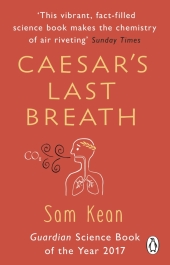 Neuerscheinungen 2018Stand: 2020-02-01 |
Schnellsuche
ISBN/Stichwort/Autor
|
Herderstraße 10
10625 Berlin
Tel.: 030 315 714 16
Fax 030 315 714 14
info@buchspektrum.de |

Sam Kean
Caesar´s Last Breath
The Epic Story of The Air Around Us. Guardian Science Book of the Year 2017
2018. 384 S. 198 mm
Verlag/Jahr: RANDOM HOUSE UK; BLACK SWAN 2018
ISBN: 1-78416-293-0 (1784162930)
Neue ISBN: 978-1-78416-293-1 (9781784162931)
Preis und Lieferzeit: Bitte klicken
The fascinating science and history of the air we breathe
GUARDIAN SCIENCE BOOK OF THE YEAR 2017
GUARDIAN SCIENCE BOOK OF THE YEAR 2017 ´Popular science at its best´
Mail on Sunday
´Eminently accessible and enjoyable´
Observer
With every breath, you literally inhale the history of the world. On the ides of March, 44 BC, Julius Caesar died of stab wounds in the Roman Senate, but the story of his last breath is still unfolding. In fact, you´re probably inhaling some of it now. Of the sextillions of molecules entering or leaving your lungs at this moment, some might also bear traces of Cleopatra´s perfumes, German mustard gas, particles exhaled by dinosaurs or emitted by atomic bombs, even remnants of stardust from the universe´s creation.
In Caesar´s Last Breath, New York Times bestselling author Sam Kean takes us on a journey through the periodic table, around the globe and across time to tell the epic story of the air we breathe.
"Absorbing, entertaining... provocative but compelling... eminently accessible and enjoyable. A real gas - in short!" Robin McKie Observer
Sam Kean spent years collecting mercury from broken thermometers as a child and now he is a writer in Washington DC. His work has appeared in the New York Times Magazine, Mental Floss, Slate, Air & Space/Smithsonian and New Scientist. In 2009 he was a runner-up for the National Association of Science Writers´ Evert Clark/Seth Payne Award for best science writer under the age of thirty. He currently writes for Science. His first book, The Disappearing Spoon, was a New York Times bestseller and was shortlisted for the Royal Society´s Winton Prize for science writing.


